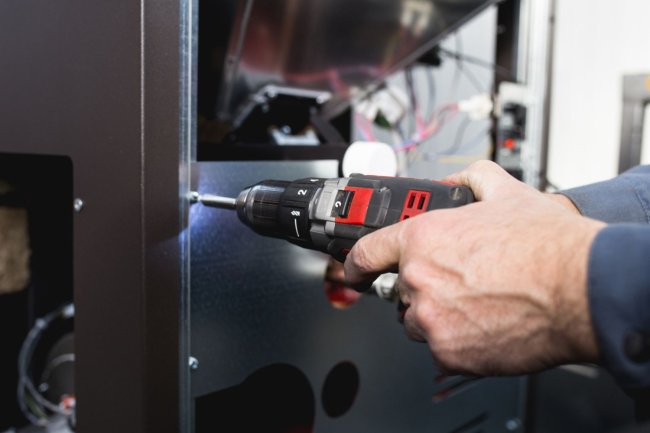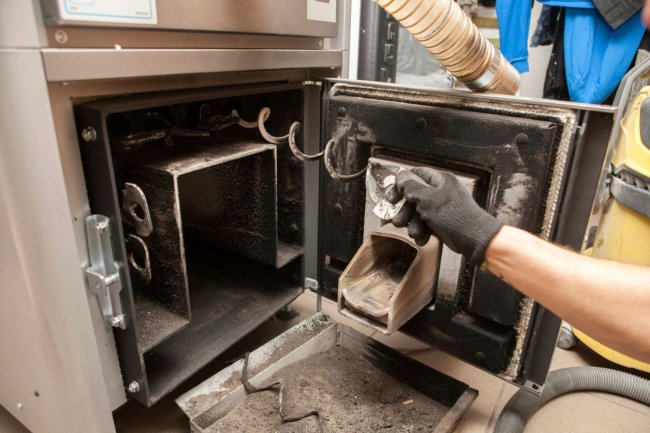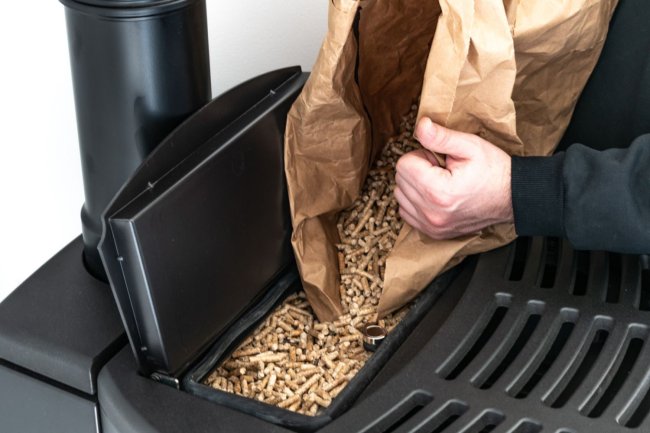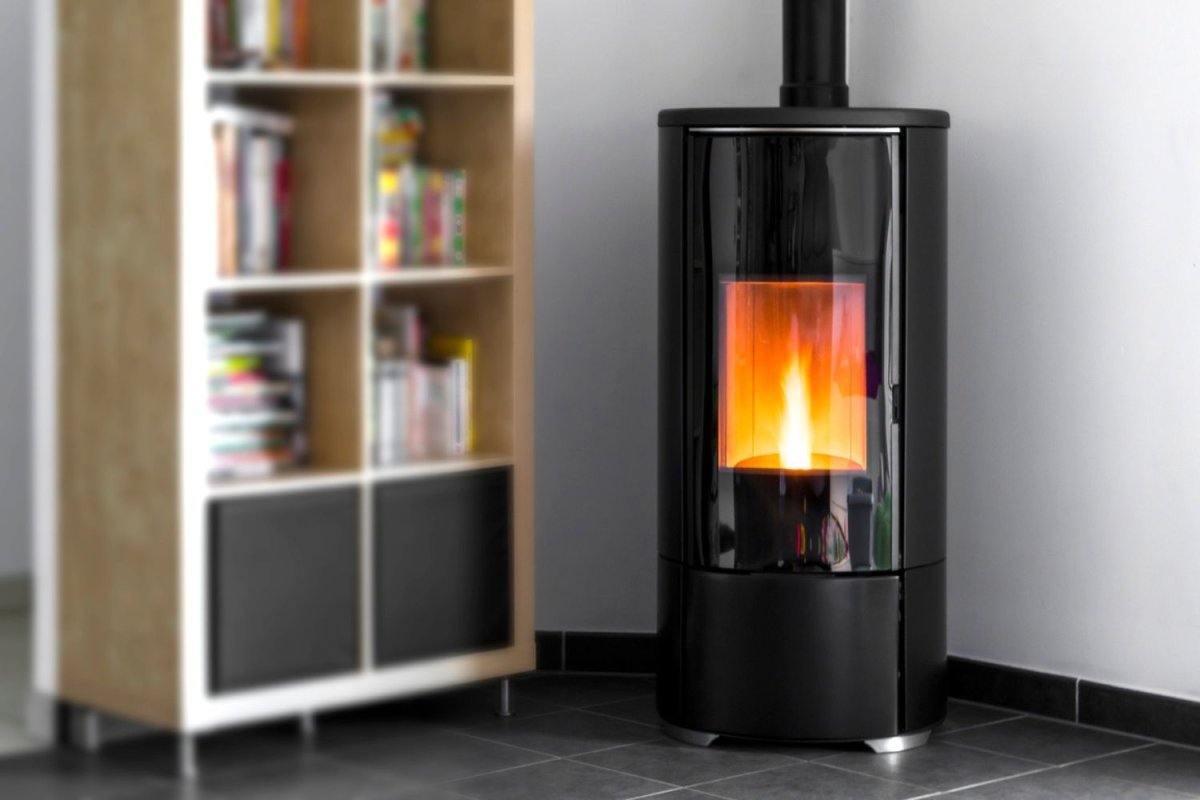We may earn revenue from the products available on this page and participate in affiliate programs. Learn More ›
Highlights
- Most pellet stove installation costs average $2,293, though a typical range is $1,036 to $3,550.
- The cost to install a pellet stove will depend on the size and type of stove, the materials and brand, labor and permits, add-ons, and any rebates or tax credits that may apply.
- More homeowners are opting for pellet stoves since they offer several benefits, such as increased efficiency and lower emissions, while also being easy to use.
- Since wood pellet stoves require electrical work and adequate ventilation, it’s recommended that homeowners hire pellet stove installers to ensure the stove operates safely.
While gas and electric furnaces are the most common appliances, there’s another option available that’s not as well known yet still effective: a pellet stove. Using electric-powered ignition, a pellet stove burns small pellets made of compressed biomass materials such as sawdust, food waste, or wood shavings to generate heat. These stoves are designed to provide heating for a home while producing minimal levels of emissions.
For homeowners who are considering installing a pellet stove, the installation cost is typically a concern. The answer to the question “How much does it cost to install a pellet stove?” is about $2,293. However, pellet stove installation cost ranges from $1,036 to $3,550, according to Angi and HomeAdvisor. There are a few factors that contribute to the range of pricing, including the size and type of stove, the installation location of the pellet stove, the brand, and extra customizations. There are often tax credits and rebates available to help lower the cost of pellet stove installation.
In addition to considering the pellet stove cost, homeowners also need to factor in the cost of the heating pellets. A 40-pound bag of pellets costs about $3 to $7. The amount needed to supply the entire winter season depends on the stove size and type, the running temperature, and the frequency of pellet stove use. Before homeowners commit to installing a pellet stove, it’s important for them to consider their specific heating needs, the layout of their home, local labor rates for installation, long-term maintenance costs, and the difference between pellet stove vs. wood stove installation costs.

Factors in Calculating Pellet Stove Installation Cost
When homeowners are calculating the cost to install one of the best pellet stoves, several important factors come into play. The national average for installing a wood pellet stove is $2,293, but this average may vary depending on the stove size and type, material costs, combustion method, pellet stove brand, local labor pricing, and permit fees. Taking all of these factors into consideration can help homeowners calculate a more accurate estimate when they start budgeting for pellet stove installation cost.
Pellet Stove Type
When making any energy-efficient home upgrades, homeowners will want to research the few different types of pellet stoves available on the market today, each with its own features and benefits. Pellet stove installation requirements vary depending on the type of stove, so homeowners will want to speak with a professional installer to choose the best option for them.
The three most common types of pellet stoves are freestanding ($1,000 to $5,000), which are self-contained units for installation almost anywhere; window-mounted units ($1,000 to $5,000), which require installation near a window for ventilation; and fireplace inserts ($2,000 to $6,000), which are usually installed in a new or existing chimney.
Pellet Stove Size
The size of a pellet stove plays a role in calculating the installation cost. Larger pellet stoves generally require more time and effort to install, which increases labor costs. The overall dimensions and weight of the pellet stove also impact the complexity of the installation project, affecting the time and effort required from the pellet stove installers.
Additionally, the size of the stove determines the heating capacity, which is measured in British Thermal Units, or BTUs. Just as with a gas furnace, BTUs are a measure of the stove’s heat output, representing the amount of warmth the stove can generate. The more BTUs a pellet stove produces, the larger the area it can heat successfully. The larger the pellet stove, the more expensive it is to install. Finding out how much a pellet stove costs can give homeowners an idea of how much to budget for the installation project.
| Pellet Stove Size in BTUs | Average Price Range (Materials Only) |
| 9,000 BTUs | $800 to $1,200 |
| 15,000 BTUs | $1,000 to $1,500 |
| 20,000 BTUs | $1,500 to $3,000 |
| 30,000 BTUs | $2,000 to $3,500 |
| 50,000 BTUs | $3,000 to $5,000 |
Material and Combustion Method
Stainless steel and cast iron are two popular material choices for pellet stoves. Each material has its own benefits, pricing, and design style. For many homeowners, the choice between the two comes down to the appearance of the pellet stove and its compatibility with the design aesthetic of the home.
- Stainless steel pellet stoves are often preferred for their durability, modern appearance, and resistance to corrosion. This material is less likely to rust or tarnish, making it a long-lasting and low-maintenance option. It’s also lighter than cast iron, which makes it easier to install. Stainless steel stoves are available in various sizes and can be loaded with pellets through the top or bottom of the stove. A downside of stainless steel is that it doesn’t hold heat well, so if a homeowner runs out of pellets, there is minimal residual heat to warm the house. Stainless steel stoves run from $1,000 to $3,000, depending on size.
- Cast-iron pellet stoves are preferred by some homeowners for their traditional, classic look. They have the ability to retain and radiate heat, but they require more maintenance to prevent rust. Cast-iron pellet stoves are available in various colors, sizes, and top- or bottom-feed styles. These stoves typically cost from $1,500 to $4,000, depending on the overall size.
Homeowners considering installing a pellet stove may have come across the terms “top-feed” and “bottom-feed” during their research. These terms refer to how the furnace pellets are loaded into the stove. While both top-feed and bottom-feed stoves serve the same purpose, the style can affect the cost of the stove.
In a top-feed pellet stove, the pellets are loaded from the top of the stove through a hopper. The pellets slide downward and are fed into the combustion chamber as needed, though the gravity feed can occasionally get jammed up. This type of pellet stove has fewer accidental fires, but it can lead to ash buildup. To avoid this potential problem, it’s recommended that homeowners use low-ash pellets. Top-feed pellet stoves cost from $1,000 to $3,500.
In a bottom-feed pellet stove, the pellets are loaded into a hopper at the bottom of the stove, and they’re moved back into the combustion chamber without causing a jam. Bottom-feed pellet stoves range from $2,000 to $4,000.
Pellet Stove Brand
One of the main ways the brand affects the cost of a pellet stove is in the quality and performance associated with each particular brand. Some brands focus on a specific feed method or style, while others manufacture a wider variety of options. Each brand has its own pricing and unique features.
- Enviro pellet stoves can cost from $3,000 to $5,000 and come in stainless steel or cast-iron styles. These high-quality stoves are easy to use, and their high efficiency produces up to 60,000 BTUs.
- Harman pellet stoves run from $2,000 to $5,000. As a prominent name in bottom-feed pellet stoves, Harman offers stoves with safety features to prevent the fire from reaching the hopper and the pellets from jamming. Available in stainless steel and cast iron, these stoves can also be controlled by remote.
- King pellet stoves range in price from $900 to $1,500. Budget-conscious homeowners typically opt for stainless steel King stoves, which come in various sizes. These stoves are top-feeding and easy to use.
- Lopi pellet stoves have a higher price range of $4,000 to $5,000. Made from cast iron for increased heat retention, Lopi pellet stoves can burn up to 57 hours on one hopper of pellets.
- MCZ pellet stoves can cost between $2,200 and $6,100. This brand makes some stoves with integrated technology that can be controlled via smartphone. The styles can be ordered in stainless steel, cast iron, or powder-coated aluminum.
- Ravelli pellet stoves range in price from $2,500 to $4,000. These stoves have remote control features and ceramic liners available in varying colors. Ravelli pellet stoves are available in traditional and more modern styles.
- St. Croix pellet stoves cost from $1,400 to $3,000. Available freestanding or as a fireplace insert, these cast-iron or stainless steel stoves are high quality and sustainable since they can burn a variety of materials.
Labor and Permits
Hiring professionals to install a pellet heater for indoor use can run from $35 to $55 per hour for labor, or between $200 and $850 on average. The overall price for pellet stove installation can vary due to the amount of vent work that is needed. For instance, adding a short vent can cost another $200 to $300, while adding a ceiling vent can run from $600 to $800.
Installing a fireplace insert can cost approximately $2,000. Since a fireplace insert uses the existing chimney, no additional venting is needed. However, a chimney liner is required to help reduce fire hazards. Chimney liners cost around $625 to $7,000 to install.
Additional Costs and Considerations
When budgeting for pellet stove installation costs, homeowners may discover additional price factors and considerations that can alter the project total. These can include operational expenses, customizations, add-ons, rebates, and tax credits.
Operational Expenses
Pellet stoves use a small amount of electricity to ignite the fire, run the fan, and keep the stove working. How much electricity a pellet stove uses depends on how often it’s used, the size of the stove, and the heat setting. The average pellet stove needs between 360 and 460 watts to start, and depending on the size of the stove and the heat setting, it can use between 80 and 345 watts per hour.
The average cost to run a pellet stove is between $40 and $50 per month, including maintenance and the cost of pellets at about $25 per month. The cost of pellets can vary depending on the frequency of use and the size of the unit. While maintenance isn’t needed every month, it’s wise for homeowners to factor in these costs when budgeting for annual operating rates.
Customizations and Add-Ons
Any type of pellet appliances, customizations, and add-ons to the pellet stove will cost extra, but some of these upgrades can help the stove run safely and more efficiently.
- Additional air vent. If the pellet stove needs to be vented through a wall instead of through an existing internal flue, installation will cost $200 to $800 extra. A ceiling vent is more expensive, while a simple horizontal wall vent will be at the lower end of the price range. Some geographic areas may have specific regulations and building codes that require a separate air vent, so it’s important that homeowners double-check the local regulations in their area.
- Carbon monoxide detector. Carbon monoxide (CO2) detectors are important to install to protect the family from carbon monoxide poisoning. Carbon monoxide is a colorless, tasteless, and odorless gas that is dangerous to humans and pets. A detector will sound the alarm if there is too much CO2 in the air, alerting residents to get outside to fresh air. Carbon monoxide detectors cost between $10 and $30 and work the most effectively when installed on every floor of the home. While pellet stoves don’t produce as much CO2 as any of the best wood-burning stoves or gas furnaces, they still produce some, so a detector is helpful for alerting residents if the levels are too high.
- Hopper extender. A hopper extender adds additional pellet storage so the pellets don’t have to be added to the hopper as frequently. Hopper extenders cost from $150 to $300.
- Metal ash vacuum. The ash pan in a pellet stove collects the ash that’s created from the pellets as they burn. Cleaning the ash pan can be a messy chore, and metal ash vacuums can make the task much easier and faster. Metal ash vacuums range in price from $50 to $140.
- Outlet installation. Since a pellet stove needs electricity to run, it needs to be installed near an outlet. If there is no outlet or the existing outlet can’t handle the needed 110 volts, a new outlet will need to be installed. Installing a heavy-duty outlet on its own circuit costs from $120 to $200.
- Pellet stove hearth pad. Available in various materials such as slate, granite, glass, and steel, hearth pads prevent heat from damaging the floor. Hearth pads are placed under pellet stoves and come in a variety of shapes, including rectangular, square, circular, curved, and teardrop. These protective pads range in price from $150 to $600, depending on size, material, and shape.
- Power supply.Wood pellet stoves can’t work without electricity. For homeowners who live in areas that experience frequent power outages, it’s recommended to have a backup power supply so the pellet stove can continue to produce heat. Homeowners can expect to pay between $150 and $600 for a backup power supply.
- Remote adjustable thermostats. High-end pellet stoves can be adjusted by remote control by changing the temperature settings. Pellet stoves with these remote adjustable thermostats range from $1,250 to $3,000 or more.
- Vent brushes. A vent brush can help keep the vents surrounding the pellet stove clean to maintain efficiency. Vent brushes cost from $30 to $80 each.
Rebates and Tax Credits
Homeowners who buy a pellet stove with an efficiency rating of 75 percent or higher are eligible for a federal tax credit of up to $2,000 or 30 percent of the final price. Some states, including Alabama and New York, offer homeowners rebates for purchasing pellet stoves. Homeowners can check to see if they qualify for tax credits or rebates in their area.

Types of Pellet Stove
Pellet stove installation cost can vary depending on the type of stove, whether it’s a freestanding pellet stove, a fireplace insert, or a window-mounted unit. Understanding how pellet stove cost is connected to the stove type can help homeowners plan their budget.
Freestanding
A freestanding pellet stove is a stand-alone stove. Unlike pellet stoves that are built into a wall or a fireplace, freestanding stoves are self-contained and can be placed anywhere in a room, which provides some flexibility in terms of installation and placement. At a cost between $1,000 and $5,000, they have a similar price to window-mounted units. Freestanding pellet stoves need to be placed on top of a fireproof hearth pad. And unless the stove is a direct vent unit that properly handles the exhaust, a vent or a chimney will need to be installed to safely vent the stove’s exhaust to the outside.
Insert
A pellet stove insert basically turns a fireplace into a pellet-burning stove. At a cost between $2,000 and $6,000, an insert costs more than a freestanding option. The overall price depends on the size of the insert and any additional features it may have or need, such as a power outlet if one doesn’t exist already. One of the benefits of installing an insert is that it can use the existing chimney as a vent, but depending on its age and condition, a chimney liner may be needed. Pellet stoves in fireplace inserts also maintain more heat than a fireplace, which sends much of the heat up the chimney.
Window-mounted or wall-mounted pellet stoves cost from $1,000 to $5,000. Window-mounted units can heat areas up to 1,000 square feet, and they use the window for ventilation so there’s no need to pay for additional vents.
Benefits of Choosing a Pellet Stove
Choosing a pellet stove has a range of benefits, which include increased energy efficiency, sustainability, cost-effectiveness, and increased aesthetics. These heating appliances offer a clean and environmentally friendly alternative to traditional heating methods.
Increased Energy Efficiency
Wood pellet stoves are designed to burn pellets with a high level of efficiency. Heating homes with wood stoves is common in some older homes, but wood stoves aren’t as efficient or easy to refuel. On the other hand, pellet stoves are designed to burn fuel with a cleaner and more complete burn since they extract more heat from each pellet, minimizing fuel waste. This increased energy efficiency is a significant benefit that can lead to lower heating costs for homeowners.
Lower Emissions
The combustion process in pellet stoves produces fewer emissions of harmful gases, such as carbon monoxide and other volatile organic compounds. By releasing fewer pollutants into the air, pellet stoves are a better option for both indoor and outdoor air quality than some other types of furnaces and stoves.
Ease of Use
Pellet stoves are easy to use, making them appealing to many homeowners. Pellet stoves often come with an automated ignition that eliminates the need for manual lighting as with a wood fireplace. And the automatic pellet feeding ensures a consistent flow of fuel to heat a home as long as the hopper has an adequate supply. Modern pellet stoves also have a built-in thermostat that can be set to maintain a consistent temperature.
Improved Aesthetics
Pellet stoves can feature clean and modern designs to complement various types of decor styles. Available in a range of colors and finishes, pellet stoves can match a homeowner’s existing furniture and interior design elements. Some pellet stoves are more compact and space-efficient to maintain the overall look of a room without dominating the space.

Pellet Stove Installation: DIY vs. Hiring a Professional
Knowing how to install a pellet stove is more complex than one might think. It requires knowledge of building codes, electrical connections, and venting systems—even with a pellet stove installation kit. That’s why it’s typically recommended that homeowners leave it to the professionals.
Improper installation can lead to safety issues, such as carbon monoxide leaks or even house fires. Hiring a pro to install a pellet stove ensures that the job is done correctly and safely, since they have the experience and skills to handle the installation process.
While hiring a professional will be more expensive, it can potentially save homeowners money in the long run since an incorrectly installed pellet stove can result in higher heating costs and future repairs. Finally, many pellet stove manufacturers require a professional installation to keep the warranty active.
How to Save Money on Pellet Stove Installation Cost
Pellet stoves are an excellent way to efficiently heat a home, but the installation cost can be a deterrent for some homeowners. With a bit of research and planning, homeowners can save money on pellet stove installation costs.
- Get multiple quotes. Homeowners will want to get at least three quotes from reputable professionals in their area to find a price that works with their budget.
- Use the existing chimney. If there is an existing chimney, homeowners may prefer to save money on venting construction and materials by choosing a fireplace insert.
- Install during the off-season. If homeowners schedule a pellet stove installation project during the warm summer months, they may be able to negotiate a better price during the installation company’s slower season.
- Look for rebates and tax credits. It’s recommended that homeowners check for available rebates and tax credits for installing a pellet stove in their area. These types of incentives can significantly reduce the overall cost of installation.
Questions to Ask About Pellet Stove Installation
Asking a pellet stove professional the right questions can help homeowners save money, avoid miscommunication, and gain a better understanding of the pellet stove installation process.
- How many years of experience do you have installing pellet stoves?
- What are your qualifications?
- Can you provide references or testimonials from past clients?
- Do you recommend any particular brand of pellet stove?
- What do I need to consider when choosing the right pellet stove for my home?
- How long will the installation take?
- Will the installation job require permits? If so, will you handle getting them?
- What safety precautions do you take during the installation process?
- Do you offer any warranties or guarantees on your work?
- Do you have any suggestions regarding maintaining the pellet stove?
- Do you offer any maintenance services?
- What should I do if I have problems with the pellet stove?
- How long do pellet stoves last?
- How can I leave a review of your work?
FAQs
Many homeowners who are considering a pellet stove are often unsure of the cost and the overall installation process. They can use these answers to some frequently asked questions about the requirements for a pellet stove, the differences between a pellet stove vs. a wood stove, and more. Understanding these aspects can help homeowners make an informed decision and budget properly.
Q. Is it cheaper to burn wood or pellets?
While pellets are more expensive to buy than wood, pellets burn longer than wood, so they require less attention from the homeowner and can cost less in the long run. On average, a 40-pound bag costs anywhere from $3 to $7 depending on the type of pellet.
Q. Do I need a chimney for a pellet stove?
Pellet stoves don’t require a chimney for use, but they do need to be vented to the outside with either a flue that runs out of an exterior wall or up through the roof. Some pellet stoves come with a direct vent option that processes the exhaust internally.
Q. What are the disadvantages of wood pellets?
Probably the biggest disadvantage of using a pellet stove is that it relies on electricity to burn the pellets. While they use a minimal amount of electricity, this can be a problem during a power outage. Backup systems or generators are recommended for homeowners who live in an area that experiences frequent power outages. It’s also helpful in case there is a shortage of pellets in different locations.
Q. Do wood pellets burn hotter than wood?
Pellets burn hotter than wood since they’re made from materials that have a low moisture content. Since dryer fuel creates more heat, pellets burn cleaner and hotter than wood logs.
Q. Is it OK to run a pellet stove 24/7?
A pellet stove can burn all day, every day, as long as it’s topped off with pellets when needed.
Q. Can I run a pellet stove without electricity?
Pellet stoves need electricity to ignite the pellets and a small amount of power to burn the pellets.
Sources: Angi, HomeAdvisor, Fixr, HomeGuide, Fireplace Universe


